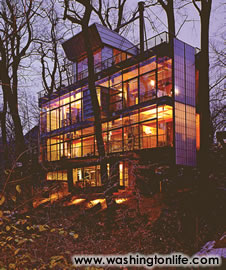|
Dig the ARCHEOLOGY of TOMORROW
Author, Professor and Architect Travis Price is on a mission to bring meaning back to our built environment
Price's designs helped Rock Creek residents realize the value of a clever addition to an existing structure with limited space. This four-level addition celebrates verticality and creates harmony between nature and familial life. Photo courtesy of Kenneth M. Wyner.
Talking to Travis Price borders on the existential. I can't help but think, as we converse over salad at Anthony Lanier's Leopold's Kafe & Konditorei, that this must be how a young student at Plato's Athenian academy felt. You catch the general gist - but just enough to leave your head spinning with deeper questions born from heightened awareness. There's no doubt Price's students in the Experiences in Architecture program at Catholic University feel much the same.
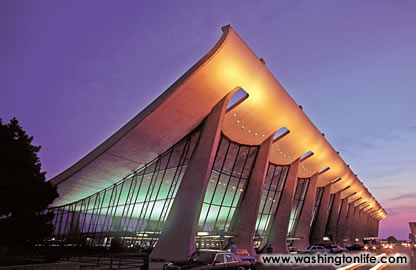 |
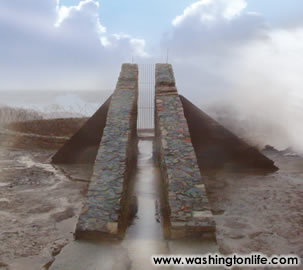 |
| Price cites Earo Saarinen's Dulles Airport Terminal as a seminal inspiration for new architectural design. Photo courtesy of Kenneth M. Wyner. |
Price and his Catholic University students designed this "modern idiom" in Doonamoe, Ireland. Considered one of the "thin places" in Celtic myth, this blowhole explodes to life when the Gale winds whip up 200-foot waves. Photo by Eamon O'Boyle. |
The founder of Georgetown-based Travis Price Architects and author of The Archeology of Tomorrow: Architecture & the Spirit of Place, Price is also the designer of the largest "green" building on the planet (the TVA headquarters complex in Tennessee). In addition, National Geographic has dubbed him a "visionary" and is flying him around the planet this month to lecture on the coattails of his book's release; and he has brought the spirit of design to both commercial and home architecture from his "tree-house" home in Rock Creek Park to such "modern idioms" as a stargazing temple in Machu Picchu. -Michael Clements
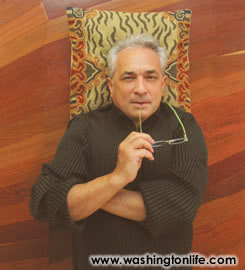 |
| Price stays grounded. |
WASHINGTON LIFE: How has your book been received?
TRAVIS PRICE: It's not just another myopic architecture book oya sabe n lofts or getaway houses. People pick it up and find a whole visual story about nature, myth, [British environmental artist] Andy Goldsworthy and art. Then it morphs into architecture, and readers keep turning pages.
WL: You've been in the vanguard of the environmental architecture movement since the '70s. Now you elaborate on the concept of "beyond green?"
TP: Green is becoming mainstream, which is fantastic, except that it has become a dangerously overused word with little meaning. When I do green, I get off the grid. There's a whole separate layer of meaning that needs to be brought back into modernist architecture, and it has to do with reconnecting to our cultural base.
WL: Is that where the notion of "spirit of place" comes in?
TP: Yes. Our culture is losing its spirit because everything has become so homogenized and banal. We've been delving into green as the architecture of the ecosphere for 30-odd years, and there hasn't been one new idea since. I can name every single [architecturally green] thing on the market and tell you where it came from. The consumption of green has not changed either. Fundamentally, we are paying less per BTU (unit of power) than ever in history - a gallon of gas costs less in terms of earnable dollars than ever before.
WL: And you can change that through design?
TP: I want people to understand the deeper meaning of design, and through it have a deeper sense of cultural mores and an understanding of how life is shaped. An analogy would be that of the over 6,000 languages spoken today, only 3,000 are being taught. In 20 years, half of them will be gone forever. The same can be applied to certain plant species. We could get a grip on that, but we're not getting a grip on losing our poetic complexity.
WL: How does that play out in blueprints and architecture?
TP: The clearest example can be seen by looking across the sprawling built-landscape beyond the Beltway. One doesn't know if one is in Phoenix, Tucson, Mississippi or Minnesota. These houses coming up could be planted anywhere. We're putting cardboard stories on the front of these houses - and maybe sometimes on the sides, if you're lucky. Same with shopping: Squint and tell me the difference between Benetton and Country Road, or between a BMW and the latest Ford Taurus. Poetry has given way to consumer-driven homogenization. Some kind of original, authentic poetic expression is missing. My calling cry is to bring the mythical back into the modern.
WL: Give me an example of a structure that isn't homogenized.
TP: Go to the East Wing [of the White House], that's a classic. The Newseum [Interactive Museum of News in Washington, D.C.] is also quite interesting.
WL: Tell me about your work at Catholic University.
TP: For almost 15 years, I have been taking students to build abstract pieces of modern idioms in foreign countries: A snake shrine in Khatmandu; a stargazing temple in Machu Picchu; a shrine to Gaelic culture in Western Island, Ireland; a shrine to Venus in southern Sicily. It has become so popular that it is now a full Master's degree called the Cultural Studies/ Sacred Space concentration. We look at every culture in the world: Judeo-Christian, Islamic, Hindu, Buddhist, all the animistic worlds from the Greco-Romans, and try to bring architecture back to the poetics. This trains young architects to not just think in terms of Bauhaus boxes or nostalgic neo-traditional phony-ism or simply green. The world would be as ugly as a woman with unshaven legs and Birkenstocks on the Champs-Elysée if we only built green style buildings.
WL: You're planning a global lecture tour with National Geographic.
TP: I'll be taking people to the world's great historic places and explaining the philosophies that made them great. I'm beginning to get deeper into archeologically enduring architecture. Architects like Antoine Predock and Frank Gehry all talk about the "three lenses." My book articulates these. The first is capturing the ecology and the landscape that exists. The second is working with the most technologically advanced building materials. The third is restoring a deep sense of the spirit of the place.
WL: What is Washington's spirit of place?
TP: Washington is guided by an exquisite sense of democracy. Pluralism should be the most prominent feature here. We're just now starting to embrace adventure and complexity in our creative architecture. To date, we've been mostly a homogenized bureaucrat's town. The thing that turns people off about Washington is that it's the world's largest classical theme park. It's an ode to neo-traditional architecture, which has been homogenized for resale. The spirit of change, dynamics and multiple opinions are missing. I would not give Washington high marks as a great city of architecture; it has four or five great monuments and two or three good buildings. If Thomas Jefferson were [in Washington] today, he'd hire whoever could make the most advanced, exciting, complex modern building imaginable.
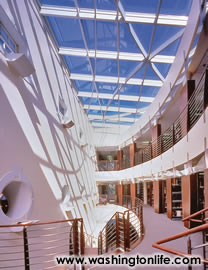 |
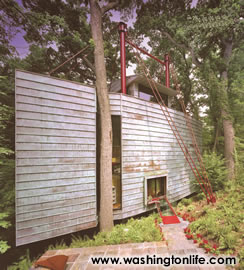 |
| Price referenced planetary paths described by Ptolemy, Copernicus and Kepler for the commercial project at his alma mater St. John's College in Maryland. Photo courtesy of Kenneth M. Wyner. |
Price's "The Archeology of Tomorrow: Architecture & the Spirit of Place" was released this month and features his Rock Creek "tree house" home on the jacket. |
| 
